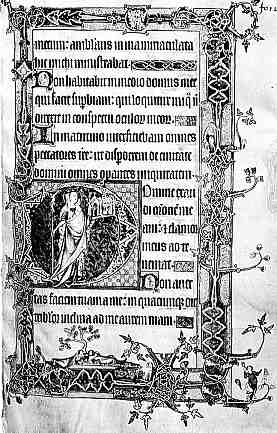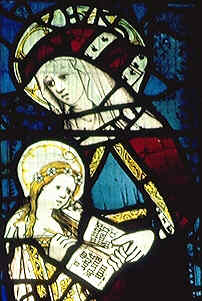




If you are looking at this page without frames, there is more information about medieval writing to be found by going to the home page (framed) or the site map (no frames).
| Modes of Reading in the Middle Ages (4) | |||
| From around the 12th century there was an increasing production of what the fancy book art people like to call de luxe volumes of core texts such as Bibles and psalters. This term calls attention to the fact that these were lavishly produced, with miniatures, historiated initials, gold leaf initials, borders and line fillers, and suggests that they were essentially for display. They may have been displayed on special occasions, but their real function was to perpetuate accurate versions of the texts required for liturgy. These were texts not only for reading, but for learning by heart. | |||
| Leaf from a lavishly decorated 14th century psalter (Douai, Bibliothèque Publique, MS 171, f.127). (From New Palaeographical Society 1903) |  |
||
| As mentioned earlier, aspects of visual layout were consciously used as aids to memory. The lavish elements of design were part of a spatial plan to identify text and commit it to memory. The text of the psalter could not just be memorised by rote from beginning to end. Specific passages had to be recalled for appropriate occasions, and recollection of the imagery aided recollection of the text. Even if the books did sit on a lectern in the church, I doubt that reading in the dim, flickering light would have been too easy. The process of reading did not just involve passing the eyes along a linear row of text, but involved the mapping of a space. This is curiously analogous to the modern process of using a web page, with its multiple design elements arranged in an orderly fashion in space, as compared to reading an old fashioned, unillustrated book with its lines of black graphic characters. | |||
| Around the 13th century, the aristocracy began to discover the joys of the written word and books. They had psalters made for their personal use, or at least for the use of their private chaplains, so that they could read them with their ears. In the competitive social environment of the time, the lavish decorative elements became status enhancing qualities. | |||
 |
Romances of Alexander in French verse, 14th century (Bodleian Library, MS Bodley 264, f.54). (From The New Palaeographical Society 1905) | ||
| Aristocrats also had fancy volumes made of certain vernacular works in the form of romances. These employed precisely the same design elements and page layout as the psalters. The texts, however, were not rigid and static. The stories grew and changed, and were altered for family political reasons, just as the oral tales from which they were derived had done. While the readers did not learn them by heart in a formal sense, the design elements must have performed a similar function in stimulating memory of a text, aiding reading. Many of the texts were in verse, a common practice for much lay literature of the later middle ages and a technique for aiding memory and assisting the learning reader. | |||
| These books were read by their owners, including women to whom some were dedicated. These were big books, and valuable items of property. They were not for private reading. Anecdotal evidence suggests that aristocratic reading was a social activity, combined with playing games, conversation and smelling the flowers. One imagines the process of reading as cooperative, carried out aloud with much help and mutual prompting, and involving reading with the eyes as well as reading with the ears. Given that no private owner had such a large number of these books, they must have become pretty well known off by heart. Reading literacy in this form did not necessarily imply writing literacy. | |||
| Vernacular literacy spread further down the social scale in the later middle ages, and there were merchants and townsmen who needed reading and writing skills in order to carry out their occupations. They acquired their books in different ways, often copying out texts themselves, producing miscellanies of sometimes unrelated texts in what have been called commonplace books. In this case reading literacy does imply writing literacy in the vernacular. It also implies a solitary occupation for reading, and a masculine pursuit. The author of the definitive edition of the 15th century Paston letters (Davis (ed.) 1971) has concluded, as a result of close study of the handwriting of the letters, that while the men of the family had both reading and writing literacy, the women were unable to write for themselves. | |||
| Clerical Latin literacy involved the precise transfer of accepted texts. Even outside the area of liturgy, glosses, patristic works and university texts were transcribed verbatim through successive generations. Students copied their textbooks from exemplars using the pecia system, or had them read to them by their lecturers while they wrote them out exactly. They read with their eyes and ears and wrote with their hands for future reference. The text was absolute. Lay vernacular literacy was selective. Readers chose their texts, and had them altered or altered them to suit themselves. The nature of the text was more closely related to oral tradition. | |||
| In the 14th and 15th centuries there were movements among the laity to take aspects of their religious practice into their own hands. While some practices and beliefs were branded as heretical, others became accepted conduct ratified by the church. The practice of the laity in reciting the Hours of the Virgin, a simplified form of the divine office as used by the clergy, resulted in the production of immense numbers of books of hours, which contained the daily office and an assortment of other texts and prayers. It also provided an encouragement for the laity to read. Images of St Anne teaching the Virgin to read have been taken as indicating official encouragment for mothers to teach their daughters do likewise. |  |
||
| St Anne teaches the Virgin to read in a beautiful 15th century stained glass window in the parish church of All Saints, North Street, York. | |||
| A large proportion of the books of hours were in Latin, and one wonders at the nature of the reading literacy which they produced. In the picture above, the Virgin is using a pointer to indicate letters in the text, suggesting an alphabetical, phonetic mode of reading. Given that the texts of the hours were repeated every day, with some for special occasions, and contained many repeating elements, this may imply an elementary phonic skill and a great amount of memory rather than an intimate understanding of Latin. | |||
| While English language books of hours were not common, probably as a result of the concerns about the Lollard heresy, vernacular books of hours in French, German or Dutch were not so rare. While vernacular reading literacy would seem to be a simpler proposition than reading in a second language, there were certain difficulties. These languages were not so regular and phonetic. They came in a range of dialect variations, so that grammar, spelling and pronunciation were variable. Even within a single document, the same word could be spelled in three different ways and there were anomalies, like the silent b, s or z of medieval French or the confusion with y, g, w and yogh in English. | |||
 |
Sample from a French language book of hours from around 1500, from a private collection. | ||
 |
Sample from a book of hours in Dutch or German dialect, from a private collection. | ||
| Vernacular reading may have been a slow process, and hard work. More than likely people became familiar with the particular kinds of texts with which they were in everyday contact, whether it was the book of hours, their favourite poem, their account books or a treatise on raising hunting dogs. There were increasing numbers of vernacular books around, but any individual only had access to a limited selection. | |||
|
|
|||
|
If you are looking at this page without frames, there is more information about medieval writing to be found by going to the home page (framed) or the site map (no frames). |
|||